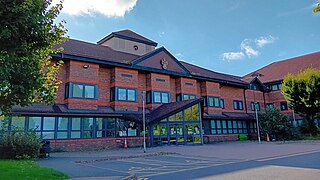Related Research Articles

South Bedfordshire was a local government district in Bedfordshire, in the East of England, from 1974 to 2009. Its main towns were Dunstable, Houghton Regis and Leighton Buzzard.

Carmarthen West and South Pembrokeshire was a constituency of the House of Commons of the Parliament of the United Kingdom. It elected one Member of Parliament (MP) by the first past the post system of election.

Carmarthen District Council was one of six local government districts of the county of Dyfed, west Wales, from 1974 to 1996.

Saundersfoot is a large village and community in Pembrokeshire, Wales. It is near Tenby, both being holiday destinations. Saundersfoot lies in the Pembrokeshire Coast National Park and on the Pembrokeshire Coast Path. The village population was recorded as 2,500 in the 2021 census.
Eglwyscummin is a community situated on the south-western boundary of Carmarthenshire in south-west Wales. It is made up of the three ward parishes of Ciffig, Eglwyscummin, and Marros, all surrounding the village of Red Roses, which lies some three miles south of Whitland and forms part of the Laugharne Township electoral ward.
The first election to Dyfed County Council was held in April 1973. It was followed by the 1977 election. The vast majority of the councillors elected had been members of one of the three previous county authorities which were merged to create Dyfed, namely Cardiganshire, Carmarthenshire, and Pembrokeshire.
An election to Carmarthen District Council was held on 7 May 1987. It was preceded by the 1983 election and followed by the 1991 election. On the same day there were elections to the other district local authorities and community councils in Wales.
Cenarth is an electoral ward, representing the communities of Newcastle Emlyn and Cenarth, Carmarthenshire, Wales. It is strangely named Cenarth, rather than Newcastle Emlyn as Newcastle Emlyn has the larger population. A similar ward for local elections prior to 1987 was named Newcastle Emlyn.
An election to the Carmarthenshire County Council was held in March 1919. It was preceded by the 1913 election and followed by the 1922 election.
An election to the Carmarthenshire County Council was held in March 1931. It was preceded by the 1928 election and followed by the 1934 election.
An election to the Carmarthenshire County Council was held in March 1937. It was preceded by the 1934 election. Due to the Second World War no elections were held in 1940 and 1943 therefore the 1937 election was followed by the 1946 election.
The first election to the Carmarthen Rural District Council in Carmarthenshire, Wales was held in December 1894. It was followed by the 1898 election. The successful candidates were also elected to the Carmarthen Board of Guardians. In rural parishes, many councillors were returned unopposed.
The 2022 Carmarthenshire County Council election took place on Thursday 5 May 2022 to elect 75 members to Carmarthenshire Council. On the same day, elections were held to the other 21 local authorities and to community councils in Wales as part of the 2022 Welsh local elections.
Carmarthen Borough Council was a Welsh municipal body created by the 1835 Municipal Corporations Act which, at that time, replaced the ancient borough that had existed since medieval times. The Council consisted of 24 members, eighteen of whom were elected councillors and the remaining six were aldermen. Councillors were elected on a triennial cycle, with a third of councillors retiring each year. Aldermen were elected for a six-year term, normally from within the council membership although retiring aldermen were often re-elected without facing a contest.
An election to the Carmarthen Rural District Council in Wales was held in April 1928. It was preceded by the 1925 election and was followed by the 1931 election. A large number of candidates had been returned unopposed. The successful candidates were also elected to the Carmarthen Board of Guardians.
An election to the Carmarthen Rural District Council in Wales was held in April 1931. It was preceded by the 1928 election and was followed by the 1934 election. A large number of candidates had been returned unopposed with only seven wards being contested. Initially, no nominations were received for the Llandawke and Llansadurnen ward, nor the Llanddowror ward.
An election to the Carmarthen Rural District Council in Wales was held on 26 March 1934. A large number of candidates had been returned unopposed with only six wards being contested.
An election to the Llandeilo Rural District Council was held on 26 March 1934. It was preceded by the 1931 election and followed by the 1937 election.
An election to the Carmarthen Rural District Council in Wales was held on 5 April 1937.
An election to the Llandeilo Rural District Council in Wales was held on 1 April 1935. The election was held following the merger of the Llandeilo and Llandovery rural districts and the need to reduce the total number of members on the new authority. Following a recommendation made in 1932, it was decided that the rural districts of Llandeilo and Llandovery would be merged. Elections were held in wards that had been amalgamated and also in wards where the number of councillors had been reduced.
References
- ↑ "Election Results in West Wales". South Wales Evening Post. 2 April 1935. p. 7. Retrieved 19 September 2024.
- 1 2 "New County Areas. Seven Districts for Carmarthenshire. Important Proposals. Whitland to be Merged". Welshman. 18 March 1932. pp. 6–7. Retrieved 5 September 2024.
- ↑ "New Rural District of Carmarthen. Effect of Amalgamation of Whitland. Elections in 14 Parishes". Welshman. 22 February 1935. p. 1. Retrieved 12 September 2024.
- ↑ "Carmarthen District Council. Forthcoming Elections. List of Nominations". Welshman. 22 March 1935. p. 6. Retrieved 9 September 2024.
- ↑ "Carmarthen Rural District Council. Election Results. First Woman Member". Welshman. 12 April 1935. p. 5. Retrieved 9 September 2024.